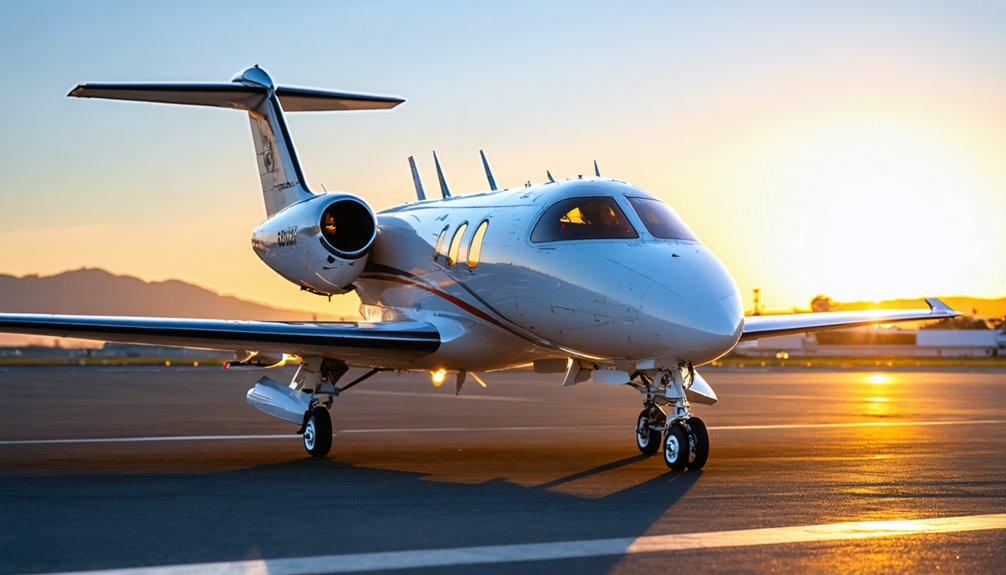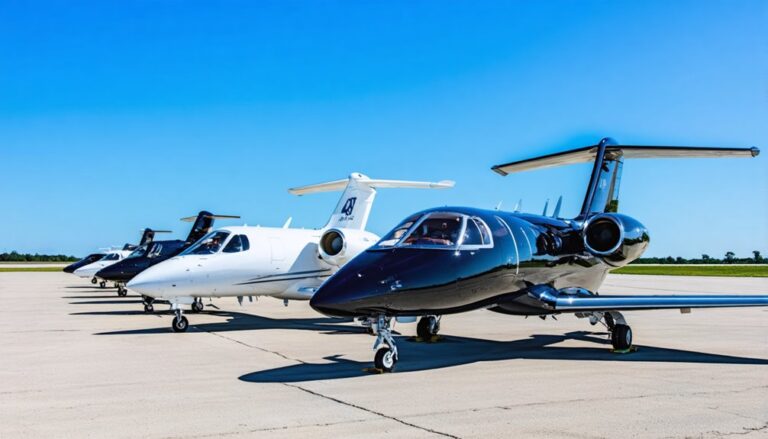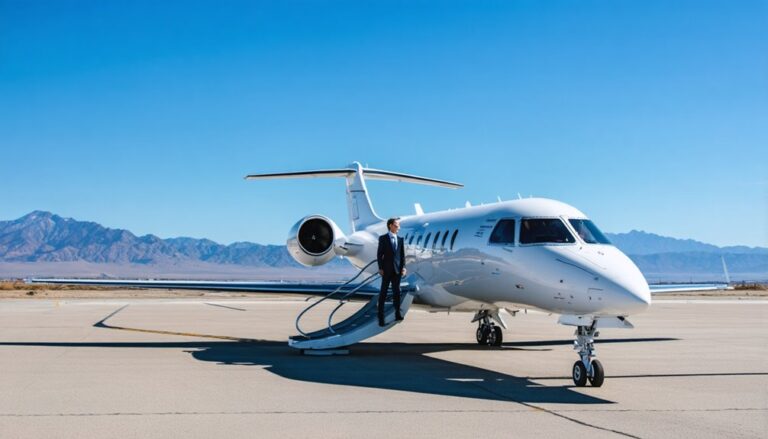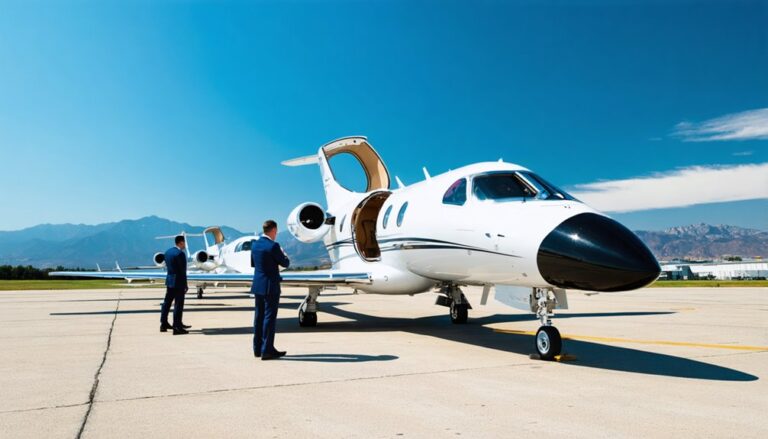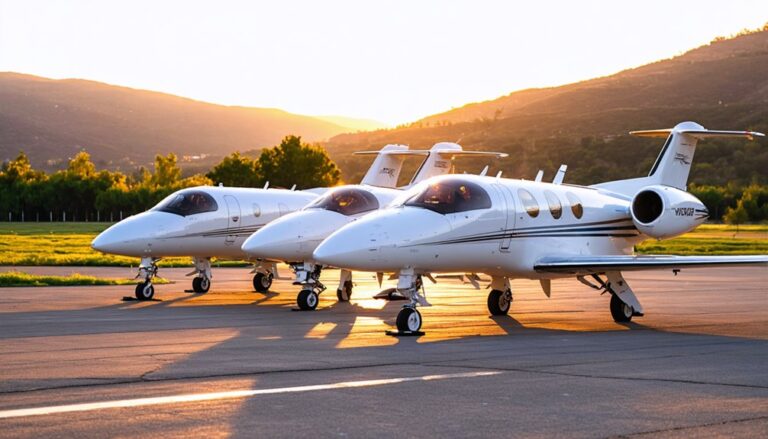Safety Features to Look for in Light Jet Rentals
When you think about renting a light jet, safety should be your top concern. Operators that follow FAA regulations and hold safety certifications like IS-BAO or ARGUS are a good choice. It’s important to check the jet’s recent maintenance records. You want to ensure it has the latest avionics systems. These systems include features like terrain awareness and weather radar, which are crucial for safe flying.
Look for jets that come equipped with a wide range of emergency gear. The crew should be well-trained in emergency procedures. This training helps them handle unexpected situations effectively. Fuel system redundancies are another key aspect. They provide backup options in case of fuel system failure. Additionally, make sure the jet’s runway performance matches your travel needs.
In conclusion, pay attention to these essential safety features. They can make a significant difference in your flying experience.
Key Takeaways
When renting a light jet, safety should be your top priority. Start by checking for important safety certifications like IS-BAO, ARGUS, or Wyvern. These certifications mean the operators follow strict safety standards.
Next, look for modern avionics systems, such as the Garmin G5000. These systems help pilots navigate accurately, which boosts overall flight safety.
Emergency preparedness is crucial. Make sure the jet has essential equipment like life vests, fire extinguishers, and medical kits. Also, confirm that the crew is trained to handle emergencies.
Safety features in the cabin matter too. Look for sturdy three-point seatbelts, reinforced cabin doors, and automatic emergency oxygen systems. These elements enhance passenger safety during flights.
Finally, consider the jet’s runway performance. It’s important that the aircraft can safely take off and land, so check its fuel system redundancies and range. This ensures a smooth and secure journey.
Essential Safety Certification Standards for Light Jets
When choosing a light jet rental for your private travel, safety certification standards should be your main focus. Legitimate operators must follow strict Federal Aviation Administration (FAA) regulations. These regulations form the basis of safety in private aviation.
Look for operators with respected certifications like IS-BAO, ARGUS, or Wyvern. These certifications show that the operator maintains high safety practices and a strong safety culture. They aren’t just formalities; they guarantee robust safety measures.
Ensure the jets are equipped with modern avionics, such as Traffic Collision Avoidance Systems (TCAS) and Enhanced Ground Proximity Warning Systems (EGPWS). These systems greatly enhance awareness during flights.
Also, ask for proof of maintenance schedules. This helps you confirm that the aircraft undergoes consistent and comprehensive inspections.
A reputable operator will always employ two qualified pilots. This adds an extra layer of skill and safety during your journey.
Advanced Avionics and Navigation Systems
Light jets are a fascinating category of private aircraft that offer a blend of performance and comfort. These jets are designed for short to medium-haul flights, making them ideal for business travel or weekend getaways.
One standout feature of modern light jets is their advanced avionics systems. These systems are essential for safety in the skies. For instance, Heads-Up Displays (HUDs) show critical flight data right in front of the pilot’s eyes. This means pilots can keep their focus forward without looking down at instruments.
Another important technology is the Terrain Awareness System. This system scans the surroundings and alerts pilots about nearby ground obstacles. Such awareness is crucial for avoiding dangerous situations, especially during landing and takeoff.
Automated Flight Controls are also a key aspect of light jets. These systems help pilots maintain altitude and navigate during complex flight scenarios. By taking over some tasks, they reduce the pilot’s workload, allowing for a smoother flight experience.
Heads-Up Display Technologies
When flying in a light jet, I always look for Heads-Up Display (HUD) technologies. These systems have changed how pilots operate in busy airspace. A HUD projects important flight information right in front of my eyes. This keeps my focus on the sky ahead, which is crucial for safety.
The aviation world has widely accepted HUDs for several strong reasons. First, they show real-time information like altitude, speed, and navigation. This helps pilots make quick decisions.
Second, Enhanced Vision Systems (EVS) are a game changer. They allow pilots to see through fog, rain, or even total darkness.
Third, Synthetic Vision is impressive. It creates a 3D view of the terrain, making it easier to spot dangers.
Finally, HUDs work well with fly-by-wire systems. This means better control of the aircraft, leading to a smoother flight experience.
Terrain Awareness Systems
Terrain Awareness Systems are crucial for aviation safety in light jets. When I look for a rental, I focus on aircraft that have TAWS. This system uses GPS technology along with detailed terrain databases. It gives real-time alerts about possible ground obstacles. This technology is vital for stopping accidents where planes unintentionally fly into the ground. This is especially important during tricky landings or when visibility is poor.
| System Feature | Safety Benefit | Available In |
|---|---|---|
| TAWS Alerts | Provides audible warnings about terrain risks | Embraer Phenom 300E |
| GPS Terrain Mapping | Offers real-time elevation awareness | Most modern light jets |
| Synthetic Vision Systems | Delivers a 3D view of the surroundings | Premium avionics packages |
| Enhanced Display Interfaces | Boosts pilot response time | Latest cockpit configurations |
These systems really improve situational awareness. They allow pilots to navigate with confidence, even in tough conditions. The peace of mind they offer is invaluable in the world of aviation.
Automated Flight Controls
When it comes to private jets, light jets are a popular choice for travelers seeking efficiency and comfort. These nimble aircraft are designed for short to medium-range flights. They offer a blend of speed and convenience that makes them great for business or leisure trips.
One feature that stands out in modern light jets is their automated flight controls. These systems help pilots manage the aircraft more easily. For instance, Garmin® G5000® avionics suites enhance navigation accuracy. They provide real-time data, which helps pilots make informed decisions.
Fly-by-wire technology is another significant advancement. This allows for more precise control of the aircraft, reducing the workload for pilots. With this system, even less experienced pilots can handle the aircraft safely.
Digital flight control systems automatically adjust the plane’s control surfaces. This ensures optimal performance and safety during flight. Additionally, runway overrun awareness systems help prevent accidents during landing. These features make flying in a light jet not only enjoyable but also safe.
Traveling in a light jet equipped with these technologies gives passengers peace of mind. They can relax, knowing that advanced safety measures are in place.
The combination of speed, comfort, and cutting-edge technology makes light jets an excellent choice for private air travel.
Emergency Response Equipment and Protocols
When I look into renting a light jet, I pay close attention to the emergency response equipment. This includes items like life vests, fire extinguishers, and advanced medical kits equipped with defibrillators.
It’s vital that the flight crew has undergone thorough emergency training. This training ensures they can carry out evacuation procedures and manage medical emergencies during the flight.
Your safety hinges on these important protocols. Therefore, I suggest you ask the operator detailed questions about their emergency preparedness before you confirm your booking.
Light jets are popular for their speed and comfort, but knowing the safety measures in place is just as crucial as the luxury of the ride.
Emergency Response Equipment Essentials

When you think of light jets, you might picture speed and efficiency. These aircraft are designed for short to medium-haul flights, making them perfect for business trips or weekend getaways. Light jets are known for their compact size and affordability compared to larger jets. They can typically seat between six to eight passengers.
One popular example is the Cessna Citation CJ3. This jet is celebrated for its performance and range, allowing travelers to fly non-stop to destinations that are a few hours away. Another standout is the Embraer Phenom 100. It offers a comfortable cabin and advanced technology, making it a favorite among many private flyers.
Light jets come with essential features that enhance the flying experience. Their efficient engines provide lower operating costs, which is a significant advantage for frequent flyers. The cabin design often includes modern amenities, such as Wi-Fi and entertainment systems, ensuring passengers remain connected and comfortable.
Safety is always a priority. Light jets are equipped with advanced navigation systems and communication tools. These aircraft often have robust safety records, thanks to rigorous engineering standards and regular maintenance checks.
When you’re considering a light jet for your next trip, think about your needs. Do you value speed? Comfort? Cost? Each jet has its unique benefits, so it’s essential to choose the one that aligns with your travel goals.
Light jets offer a flexible and enjoyable flying experience, perfect for both business and leisure.
Advanced Medical Kits
Advanced medical kits are crucial for light jets. They go beyond the basic first aid kits often found on commercial flights. When I look into charter options, I make sure the aircraft has essential items like defibrillators and oxygen tanks. These tools are vital for handling medical emergencies in the air.
Top-notch operators keep these medical kits in excellent condition through regular checks. They also have clear steps for using the equipment during emergencies. It’s smart to choose providers that offer medical consultation via satellite. This way, you can talk to healthcare professionals while flying. This preparation boosts passenger safety and gives you peace of mind at cruising altitudes.
Light jets, known for their speed and efficiency, are a popular choice for travelers. Their smaller size allows for access to more airports, making them flexible for various flight paths. They’re perfect for quick trips, and knowing they’re equipped with advanced medical kits adds to their appeal.
Choosing a light jet with a well-stocked medical kit ensures you’re ready for any situation while enjoying the freedom of private travel.
Crew Emergency Training
Light jets are a popular choice in private aviation. They serve well for short to medium-haul flights. Their size makes them ideal for accessing smaller airports, which helps avoid long wait times.
When considering a light jet, think about the types available. Examples include the Citation CJ3, Embraer Phenom 300, and Learjet 75. Each offers different features and performance capabilities. The Citation CJ3 is known for its speed and range, while the Phenom 300 boasts a spacious cabin. The Learjet 75 combines luxury with advanced technology.
Safety is crucial. Top operators invest in crew emergency training. This training ensures that flight crews can handle emergencies confidently. They train in using emergency equipment, conduct regular simulations, and emphasize communication. These practices are essential for passenger safety.
Operators who prioritize these training protocols significantly enhance their service quality. By going beyond basic requirements, they ensure readiness for any situation.
When flying in a light jet, knowing that well-trained professionals are at the helm provides peace of mind. You’re not just choosing a mode of transport; you’re opting for a secure and comfortable experience.
Structural Integrity and Airframe Design
When it comes to light jets, safety is essential. A key factor is the structural integrity and airframe design. I always choose jets with strong airframes made from aluminum alloys and advanced composites. These materials provide excellent strength while keeping the weight down.
The monocoque structure in quality light jets spreads stress evenly, which helps them withstand unexpected turbulence.
One jet that stands out is the Citation CJ3. It features cutting-edge aerodynamics that improve stability in tough weather conditions. Before I book any flight, I check to make sure the jet has a solid maintenance history. Regular airframe inspections every 12 to 24 months are crucial.
This focus on safety is more than just ticking boxes; it ensures that private flight remains safe and enjoyable.
Weather Detection and Avoidance Technology
When it comes to flying light jets, weather detection and avoidance technology stands out as a key safety feature. Modern radar systems empower pilots to navigate confidently, even in less than perfect weather.
I look for jets that come with essential safety tools:
- Enhanced Flight Vision Systems – This technology boosts visibility, helping pilots land safely in tough conditions.
- Advanced Radar Systems – These systems spot severe weather patterns, allowing for safer navigation around storms.
- Predictive Weather Algorithms – They provide real-time updates, enabling pilots to adjust flight paths proactively.
- Automatic Dependent Surveillance–Broadcast (ADS-B) – This feature improves situational awareness by sharing traffic and weather information.
These technologies form a comprehensive safety net. They help pilots maintain control while flying through challenging environments.
As a result, you can fly with greater peace of mind, knowing that advanced tools are working to keep you safe.
Pilot Experience Requirements and Training
When renting a light jet, it’s crucial to consider the pilot’s experience alongside the aircraft’s mechanical reliability. The Federal Aviation Administration (FAA) sets minimum certification standards for pilots. These include specific flight hours and qualifications for the aircraft they operate. Reputable charter companies often exceed these standards. They usually hire pilots with over 1,500 flying hours for the Pilot-in-Charge and at least 500 hours for First Officers.
Ongoing training is vital for pilot competence. In addition to initial certifications, pilots participate in regular training sessions. They practice in simulators, engage in emergency drills, and receive training tailored to specific airports. This continuous education ensures that pilots are prepared for any challenges that may arise during your flight in a light jet.
When you board a light jet, you can feel confident knowing that experienced pilots are dedicated to your safety. Their extensive training and commitment to excellence play a significant role in making your journey smooth and enjoyable.
Minimum Certification Standards
Three key certification standards ensure safety in light jet rentals. When I book a charter, I check these standards to make sure my trip is safe and enjoyable.
First, the Pilot-in-Charge must have a minimum of 1,500 flight hours. This includes specific experience with the light jet model being used. Knowing the pilot has this experience gives me peace of mind.
Second, First Officers are required to have over 500 flight hours. This experience is crucial for handling both normal operations and emergencies effectively.
Third, all pilots undergo regular simulator training and recurrent training. This helps them stay skilled and ready for any situation that may arise.
Lastly, the operator must have a solid training program. This program covers emergency protocols and operations at challenging airports.
These standards serve as an essential safety net. When I’m flying at high altitudes, I want to know that everything is in place for a secure journey.
Ongoing Training Programs
Four key ongoing training programs support safety in the light jet charter industry. When booking a jet, I always check that pilots undergo recurrent training every six months. This ensures they’re current with safety protocols and operational procedures.
Top charter companies expect their pilots to exceed the minimum requirement of 1,500 flight hours. This shows their dedication to your safety through real-world experience.
Regular simulator sessions are essential. These sessions keep pilots sharp in emergency procedures and quick in decision-making.
Choose operators that emphasize continuous education on regulatory updates and emerging aviation technologies. This ongoing training develops pilots who aren’t just certified—they are genuinely ready to handle any situation during your flight.
Light jets, known for their speed and efficiency, are perfect for short to medium-haul flights. They offer comfort and convenience, making them popular among business travelers.
Many light jets also come equipped with modern amenities, ensuring a pleasant journey.
Maintenance Records and Inspection History
When considering a light jet rental, it’s crucial to examine maintenance records and inspection history.
These documents reveal the true airworthiness and dependability of the aircraft. Before entering any rental agreement, always check the service history. It shows the real condition of the jet, beyond just its appealing exterior.
A jet’s maintenance history unveils its true reliability—look beyond the polished exterior before signing any agreement.
Look for specific details in the maintenance records:
- Complete documentation of repairs, inspections, and modifications that confirm compliance with safety regulations.
- Proof of regular maintenance checks as recommended by the manufacturer.
- A detailed history of inspections, including A, B, C, and D checks, along with their dates and outcomes.
- Third-party safety audits from reputable organizations like ARGUS or Wyvern.
Don’t just take someone’s word for it. Insist on reviewing these records.
Your ability to fly safely should never be compromised.
Runway Performance and Airport Compatibility
When renting a light jet, you need to think about more than just maintenance records. Runway performance and how well the jet fits with the airport are crucial for safety.
Modern light jets, like the Phenom 300E, come with advanced systems that help prevent runway overruns. This can make a big difference during takeoff and landing.
If you plan to fly to smaller airports, check if the jet’s takeoff and landing distances match the runway lengths available. The Phenom 300E is known for its excellent short-field capabilities, which means you can reach more destinations easily.
Models like the Cessna Citation Latitude offer high-tech avionics that improve your awareness of the surroundings, helping you maneuver through tricky airport situations.
For airports located near tough terrain, look for jets that are certified for steep approaches. This certification can be vital for safety.
Also, jets with great climb performance will help you rise quickly above bad weather, which adds an extra layer of safety.
Ultimately, choosing the right light jet is about ensuring a safe and efficient flight experience.
Cabin Pressurization and Oxygen Systems
When flying at high altitudes, cabin pressurization and oxygen systems are essential for safety in light jets. I check these systems when choosing a jet because they greatly affect safety and passenger comfort.
Safety at altitude demands reliable pressurization and oxygen systems—the first features I inspect when selecting a light jet.
Regulations in aviation require that these systems are regularly maintained to ensure they work properly when needed.
Here’s what I look for in light jets:
- Cabin pressurization should keep the equivalent altitude at 8,000 feet. This helps reduce fatigue on longer flights.
- Automatic oxygen deployment systems must activate right away if pressure drops. This feature is vital for immediate safety.
- Dual oxygen systems are important. They provide a backup if the primary system fails.
- I also want to see detailed maintenance records. These records should show regular inspections of both systems.
Don’t overlook these features. They act as your silent protectors against the risks of hypoxia at altitudes above 10,000 feet, allowing you to fly freely and safely.
Always prioritize these elements when considering light jets for your journeys.
Modern Communication Systems and Connectivity
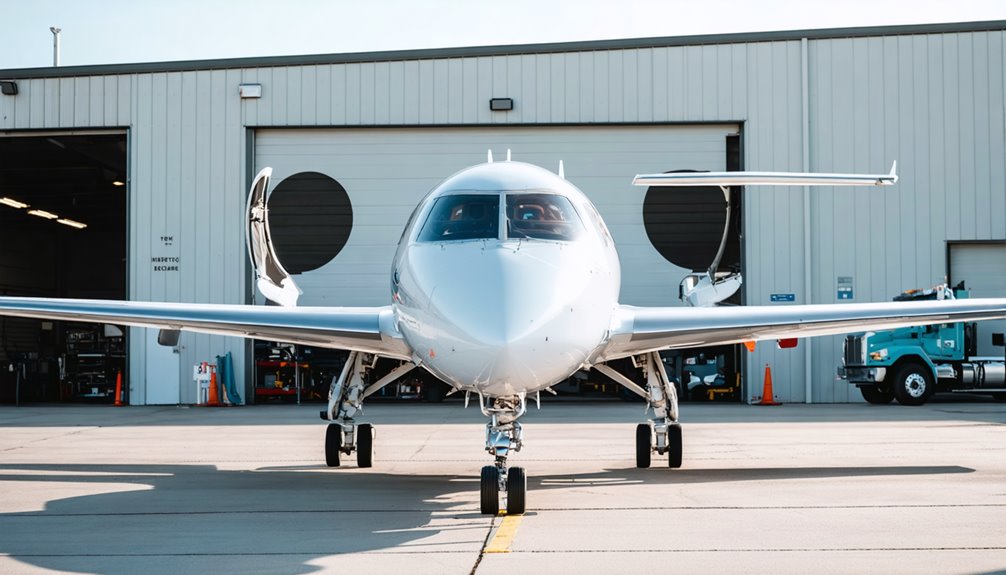
When it comes to private jets, light jets stand out for their efficiency and versatility. These aircraft are ideal for short to medium trips, offering a comfortable experience without the need for large airports.
In my experience, choosing a light jet involves looking at features like the Garmin G5000. This advanced avionics system boosts navigation accuracy and improves communication between pilots.
In-flight Wi-Fi plays a crucial role too. It’s not just for entertainment; it gives pilots access to real-time updates on weather and other important information. This connectivity helps them navigate safely through changing conditions.
Integrated flight management systems also enhance awareness in the cockpit. They simplify complicated tasks, allowing pilots to focus on flying.
Clear communication is vital. Enhanced Communication Systems ensure that pilots and air traffic control can talk without misunderstandings. This reduces risks and keeps everyone safe.
With the ability to share data quickly, pilots can make informed decisions in an instant, giving passengers peace of mind during their journey. Whether you’re flying for business or leisure, light jets offer a smart and reliable choice.
Fuel Systems and Range Safety Considerations
Light jets are an exciting option for private air travel. Their fuel systems play a key role in ensuring safety and performance. When I look at these jets for my clients, I focus on how their fuel systems enhance both safety and travel range.
Many light jets today offer impressive fuel efficiency. They can fly up to 2,000 nautical miles, which is quite remarkable. This is achieved without sacrificing safety.
Today’s light jets achieve remarkable range—up to 2,000 nautical miles—while maintaining exceptional safety standards and fuel efficiency.
Here are the safety features I consider essential when evaluating these jets:
- Redundant fuel tanks: These ensure that even if one tank has a problem, the other can still provide fuel.
- Accurate fuel indicators: These tools help pilots understand how much fuel is available, which is crucial for planning flights.
- Warning systems: These alerts notify pilots about potential fuel issues before they escalate, maintaining safety.
- Safety compliance: All fuel components must meet strict aviation safety standards to ensure reliability.
These features work together to provide peace of mind.
When you fly in a light jet, you can focus on your journey while knowing safety is a priority.
Noise Reduction and Environmental Compliance
Light jets are a fascinating category of private aircraft. They’re designed for speed, comfort, and efficiency.
For instance, the Phenom 300E stands out due to its remarkable noise reduction features. Advanced insulation materials and carefully placed engines help keep cabin noise to a minimum. This means you can work or unwind without disturbances. You’ll appreciate the calm atmosphere the moment you step inside.
These jets are also built with sleek aerodynamic shapes. This design not only makes for a smoother ride but also helps meet strict environmental regulations.
Modern light jets use fuel-efficient engines that lower carbon emissions and minimize noise during takeoff and landing. Such features are essential for travelers who care about their impact on the planet. Plus, they allow you to fly to airports with tough noise restrictions. This opens up more travel options while ensuring you enjoy a quiet journey.
Light jets combine luxury with responsibility. They offer a unique way to travel that aligns with both personal comfort and environmental consciousness.
Passenger Restraint Systems and Cabin Security
When it comes to light jet travel, passenger safety is crucial. This is where advanced restraint systems and robust cabin security come into play. Top private aviation providers focus on your safety while ensuring you enjoy the freedom of flying.
When you look for a light jet to rent, pay attention to these important safety features:
- Three-point seatbelts are essential. They keep you secure during takeoff, landing, and turbulence.
- Cabin doors should be reinforced. Strong locking mechanisms help stop unauthorized access.
- Automatic emergency oxygen systems are vital. They activate quickly if cabin pressure drops.
- Handholds and grab bars should be strategically placed. These help you maintain stability during your flight.
Reputable operators perform regular safety checks on all these systems. They follow strict FAA regulations to make sure your journey is safe and enjoyable.
Frequently Asked Questions
What Is the Safest Jet to Fly On?
When it comes to light jets, the Gulfstream G650 stands out with impressive safety ratings. It features advanced in-flight technology that enhances the overall flying experience. This jet also has well-planned emergency protocols, which are crucial in ensuring passenger safety.
However, it’s important to remember that the qualifications of the pilots and the maintenance standards of the aircraft play a significant role in safety. A well-trained pilot can make a big difference in how a flight goes. Regular maintenance checks ensure that the jet operates smoothly.
In the world of light jets, the G650 is a strong choice, but always look beyond the specifications. The overall safety of a flight depends on many factors, including the people involved in its operation.
What Is the Fatality Rate of Private Jets?
Light jets are a popular choice among private jet types. They are known for their speed and efficiency. The safety record of light jets shows about 2.3 fatalities per 100,000 flight hours. This number is higher than commercial airlines, but it’s still much safer than driving a car.
One key factor in safety is pilot training. Pilots undergo rigorous training to handle various situations. This training significantly reduces the risks associated with flying. Light jets, like the Cessna Citation and Embraer Phenom, have modern technology and safety features that enhance their reliability.
What Is the Safety Record for Private Jets?
Private jets come in various types, and one popular category is light jets. Light jets are known for their efficiency and speed. They are perfect for short trips and have a seating capacity that usually accommodates up to seven passengers. Brands like Cessna and Embraer produce well-regarded models in this category.
When it comes to safety, light jets have an impressive record. With strict regulations and high maintenance standards, these aircraft are built to minimize risks. Pilots undergo extensive training, which further enhances safety. Statistics show that private aviation has only 2.3 fatalities for every 100,000 flight hours, making it significantly safer than driving a car.
What Safety Measures Are Built Into Airplanes for Passenger Safety?
Light jets are a popular choice for private air travel. These nimble aircraft are designed for short to medium distances. They offer speed and efficiency, making them great for business trips or weekend getaways.
Safety is a top priority for light jets. They undergo strict maintenance checks to ensure everything is in top shape. Pilots also receive thorough training, which prepares them for various situations. This training includes emergency protocols, so they know exactly what to do if something goes wrong.
Light jets come equipped with advanced safety features. Many have modern avionics that help pilots navigate and monitor the aircraft’s systems. Additionally, these jets are built to handle turbulence effectively, providing a smoother ride for passengers.
When you fly in a light jet, you can feel secure. The combination of regular maintenance, skilled pilots, and cutting-edge safety equipment gives you peace of mind. Whether for business or leisure, light jets ensure a safe and enjoyable flying experience.
Conclusion
When choosing a light jet for rent, safety features should be your top priority. I learned this firsthand after a close call where my pilot used advanced weather radar to steer clear of dangerous turbulence over the Rockies. That experience taught me that no luxury in the cabin is worth it if the jet’s safety systems don’t meet high industry standards.
Light jets, known for their speed and efficiency, can vary greatly in their safety features. Look for jets equipped with advanced avionics, such as Enhanced Ground Proximity Warning Systems (EGPWS) and Traffic Collision Avoidance Systems (TCAS). These technologies can significantly reduce the risk of accidents.
Another critical aspect is the jet’s maintenance history. A well-maintained aircraft is much safer. Make sure to ask for records that show regular inspections and adherence to safety protocols.
Remember, flying should be a safe experience. Prioritizing safety features in your light jet rental gives you peace of mind in the air.
